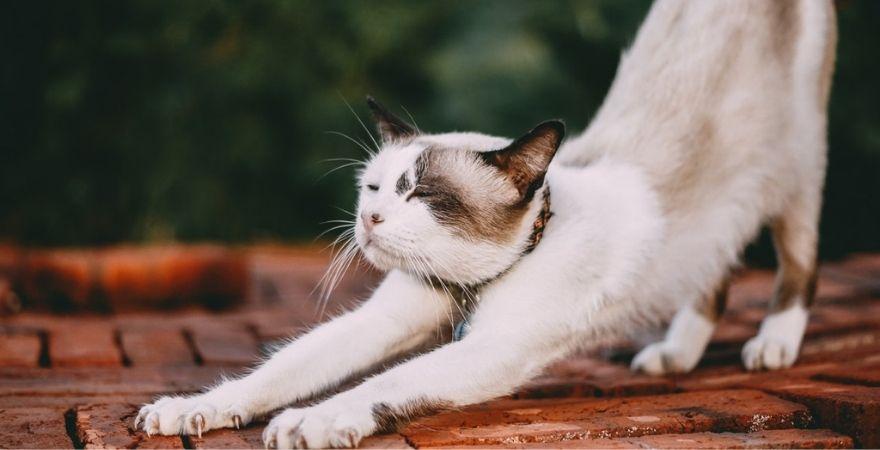Cat UTI: Symptoms and Causes
Is your cat straining to pee or has blood in their urine?
These are common signs of uti in cats (where UTI stands for urinary tract infection.) But here's the rub, these symptoms are general and it's not nailed on the cause is an infection. This is why cat uti signs may be also described as feline lower urinary tract disease (FLUTD), feline urological syndrome (FUS), or feline idiopathic cystitis (FIC).
To tell these urinary conditions apart requires the vet to check out and pin down the underlying cause, such as infection, urinary crystals, or stress. The important take-home message for the caring cat guardian is to be alert for cat uti symptoms and seek veterinary attention sooner rather than later.
Warning Signs of Feline Urinary Tract Infections
The early signs of UTI in cats relate to a sore bladder. When a cat UTI is left untreated, complications may develop such as a plug or blockage forming in the urethra or even infection tracking up to the kidneys. Bladder blockages are life-threatening, so it is wise to seek veterinary assistance at the first sign of bladder discomfort. This is especially true for male cats, whose anatomy makes it easier for plugs to form.
Early cat UTI symptoms include:
- Squatting outside the litter box and peeing in odd places
- Frequent trips to the tray
- Only producing small puddles or a few drops of urine
- Blood in the urine
- Crying or vocalizing when using the tray
- Licking the rear end more than usual
- Seeming restless and uncomfortable
If the problem is not treated then complications can occur. A blocked cat is depressed, weak, off their food, and may collapse and die. Urgent veterinary help is essential, preferably before they get so sick.

Which Cats Get Urinary-Tract Infections
A true cat UTI caused by bacteria is less common than you might think. Indeed, only around 3% of young cats with symptoms of cat UTI are down to infection.
However, some cats are more at risk of infection than others. For example, female cats are more at risk of infection, because bacteria can track up their urethra into the bladder (so lying in a dirty litter box is a bad idea). However, if a male cat has a UTI it can be more serious because their urethra is narrow and twisting, making it easier for a blood clot or debris to form a plug.
Bacterial infections also tend to happen in older cats. This is because the seniors produce weak urine, which has fewer natural antiseptic qualities. A health condition which causes the cat to drink more, such as overactive thyroid glands or kidney disease, also makes a true cat UTI more likely. Another cause of UTI in cats is diabetes mellitus (sugar diabetes) as the sugar in their urine acts as food for bacteria and helps them to grow.
This doesn't mean that young cats don't get symptoms of cat UTI, because they do. But it does mean the cause is often not bacteria but something else such as stress or crystals in their urine.

Causes of Feline Urinary Tract Infections
Let's say you see cat UTI signs: What might be the cause?
- Bacterial infections: More common in older, female cats. Bacteria enters the urethra and tracks up into the bladder.
- Urine crystals or bladder stones: Crystals can form in urine, which then chafe the lining of the bladder leading to cat UTI symptoms. These crystals may clump together and form a solid stone, which risks blocking the urethra.
- Idiopathic cystitis: This is inflammation of the bladder wall which leads to cat UTI signs. The cause is often stress, which causes inflammation of the nerves in the bladder wall.
- Polyps: Some cats develop fleshy, non-cancerous growths within the bladder
- Bladder cancer: Sadly, bladder cancer can mimic the signs of cat UTI, however bladder cancer is rare and is limited to older cats.
Diagnosing a Feline Urinary Tract Infection
The first step to diagnosing a cat UTI requires a urine sample. A simple dipstick test highlights if blood is present, which means further investigation is necessary.The vet may then do a rapid in-house test which gives a 'yes or no' answer if infection is present.
If infection is present, the urine needs to be cultured. This takes a few days with the idea being to grow any bacteria present which allows the lab to work out which antibiotic works best against them.
For cats that get repeated infections, blood work helps to screen for underlying health conditions which may predispose the four-legger to bladder problems.
If no infection is present but cat UTI signs are present, additional tests include examining a urine sample under the microscope to look for crystals and an ultrasound scan of the cat's bladder to rule out stones.
Cat UTI symptoms rarely go away on their own, and veterinary treatment prevents pain and reduces the risk of serious complications. However, there are plenty of ways you can reduce the risk of bladder discomfort, which are covered here.
(Psst... if you want to support your cats UT health and help keep UT infections crystals and other nasties at bay - check out our UT Wellness Chews here)
Dr. Pippa Elliott, BVMS, MRCVS
Veterinary surgeon, Linkedin
Dr. Elliott graduated from the University of Glasgow, UK, with a Bachelor of Veterinary Medicine and Surgery. She has over three decades of experience working in companion animal practice and is the designated veterinarian for the Cats Protection rescue center, Harrow.



